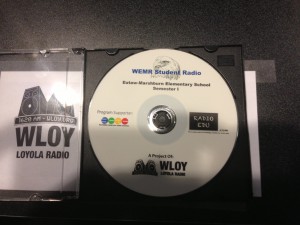Radio Edu
Happy New Year from RadioEdu!
Wednesday, January 1st, 2014 by WLOY Staff
How many fifth gradersdo you know with a CD release?
Happy New Year everyone! RadioEdu ended the Fall 2013 semester in an extremely exciting fashion with a CD release for the students! This was a wonderful event highlighting the accomplishments of three remarkable fifth grade students. The amount of material that they were able to master in a short amount of time continues to astonish me as I look over the blog entries of the past three months.
We are looking forward to another great semester filled with exciting and challenging projects, and I have no doubt that the students will continue to demonstrate mastery over the increasingly difficult material while gaining confidence in their production techniques. This year we will continue with the project-based learning approach, while aiming to integrate a long-term collaboration providing the students an opportunity to demonstrate increasing autonomy in regard to audio production. We will continue to develop and hone core audio production skills and look to post more incredible content each week!
Thanks for all the support and for helping to make the first semester of RadioEdu at Eutaw-Marshburn a success!
Jonathan
Posted in News, Radio Edu | No Comments »
RadioEdu Week 12: Part Two
Friday, December 13th, 2013 by WLOY Staff
Concepts: Cutting Loops, Advanced Editing, Recording Vocals over Soundbeds
While M worked on mixing and finalizing her track, J was working on another ‘Top Ten’ list, this time thinking more about how the loop would sound under what he was planning. He decided to do a ‘Top Ten Worst Video Game Cliches’ and already had a vision of what the track would sound like.
He selected a few different basslines that he liked, and then cut them up and rearranged the audio samples into his own groove. He manipulated the audio slices and even began to comfortably use the ‘reverse selection’ function to enhance his new bassline. J has developed a go-to method that he uses for this process, which involves keeping the original audio file intact on a separate, muted track. This allows him to easily go back and cut out the sections he wants. I’m going to post screenshots of J and M’s arrangement so that everyone can see the detailed cutting and editing of the looped segments.
After recording this, J did a quick mixdown of the 30 second clip and looped it under his ‘Top Ten.’ We then listened and mixed it Thursday morning. M wanted to add some drums to J’s original bassline, so Thursday I had her and J work together to accomplish this task. M did an excellent job chopping up the beats and layering them in, and realized that it’s often quite difficult to add drums to an already existing line, especially if that piece was done without drums to begin with.
The project was more an exercise in working to place audio visually, as M used the waveforms to line up the hits, just as she did in her 30 second track from Wednesday.
We finished the session with M recording a recipe segment where she walked the listeners through creation of one of her favorite meals. Make sure to keep posted for this file next week!
J’s Top Ten Cliches
J and M Combo
Posted in News, Radio Edu | No Comments »
RadioEdu Week 12: Part One
Friday, December 13th, 2013 by WLOY Staff
Concepts: Cutting Loops, Advanced Editing, Recording Vocals over Soundbeds
This was a tremendously productive week for the students! We covered so many valuable topics that I need to write a two part blog entry to cover everything. Since we had two abbreviated yet successful weeks, this was a very invigorating week and the students demonstrated that they have not forgotten anything during our shortened sessions.
We began by revisiting J’s piece from last week: his first attempt at recording a ‘Top Ten’ over a looped soundbed that he created. The students listened to the mix and provided their feedback, and J was able to analyze his mix and offer input on the things that he did and what he would change. I also briefly introduced the Phaser effect, and the students had fun listening to the impact it had on morphing audio, especially vocals and drum sounds. We will revisit the Phaser next week.
Since the students had two snow days this week, I decided to have them do an impromptu radio show about the things that they liked and disliked about the snow, and what they did during their time off. The purpose of this exercise was to emphasize the importance of transitions and smoothness during a radio show, and they have noticeably improved their abilities to talk with little downtime!
In the Wednesday afternoon session, we focused on more advanced skills involved in manipulating and editing audio loops. We reviewed the previous techniques, and both J and M were given the task to create a 30-40 second track that would serve as a soundbed for a segment that they were to record at the end of the session.
M began right away, and started with a drum track and then layered in some piano, sound fx, and synths. She came up with the arrangement herself, and cut and looped the audio to match what she envisioned. She then worked through the mix herself to optimize the sound.
On to part 2!
M’s Beat
Posted in News, Radio Edu | No Comments »
RadioEdu Week 10 & 11
Friday, December 6th, 2013 by WLOY Staff
Concepts: Advanced Audio Editing, Interview Skills
Hello everyone! The last two weeks have been abbreviated due to Thanksgiving and holiday travel plans, so I’ve decided to do a quick post combining the session notes for each week. We’ve been focusing on expanding our editing skills, and further building on the techniques involved in creating loop-based compositions. Thanksgiving week, J was able to work in depth on a piece he’s envisioned as the backdrop soundbed for one of his ‘Top Ten’ lists. In creating the piece, he was able to select several source audio files and cut them into individual slices, and then process several of the slices.
Through this project, he discovered the ‘reverse selection’ function and began to experiment with organizing his cut audio into completely new clips, integrating several of the newly reversed slices. This is a very advanced concept and requires precision with cutting and a solid ear for layering the resulting clips. He then created a working soundbed from his track and recorded himself speaking over it, marking the first session in which one of the students recorded over a soundbed that they created!
I also had J take a few moments to teach his classmates some of his secrets for chopping and pasting audio. I’ve posted the resulting short beat that he created to show them. He looped a drum break and then cut a vocal line and matched it using the visual element of the waveforms.
Since we had only one session the week of 12/2, we focused on reviewing interview skills and discussing future plans. As a proof of concept, we did a 15 minute ‘talk show’ and the students have all improved so much in their confidence levels, question asking, and with the ‘unseen’ skills such as mic awareness.
We look forward to getting back on our regular schedule next week!
J’s ‘Happy Waves’ Soundbed
J Top Ten Worst Characters
J Teaching Cuts
Posted in News, Radio Edu | No Comments »
RadioEdu Week 09
Friday, November 22nd, 2013 by WLOY Staff
Concepts: Advanced Audio Editing for Loops, Mic Awareness for Live Recording
This was an abbreviated week, so we focused mainly on reviewing concepts from previous weeks while also discussing some of the ‘unseen’ studio skills regarding awareness of one’s surroundings while working with live mics. Throughout the last several weeks I’ve been providing tips to the students while they are recording. These are usually centered around awareness while recording, such as making sure one is aware of touching the mic cables while they are recording as this causes a ‘spike’ in the recording. Some of the other concepts that we’ve been practicing include making sure that they are at an acceptable and consistent distance from the mics, and also making sure we practice talking in loud and confident voices so that there is less need to boost the gain after the recording. The students have been improving in these areas over the weeks, and this was a time to check in on their progress and review these ‘hidden’ skills that have been improving.
We also delved further into the realm of loop editing and the process of cutting sounds and segments from a larger audio file in order to create their own rhythms and grooves. The students ultimately will produce soundbeds for their own segments as well as an introduction for their own radio segment, and so this skill review was a great reminder of how far they’ve come and also helped clarify upcoming goals.
Posted in News, Radio Edu | No Comments »
RadioEdu Week 08
Friday, November 15th, 2013 by WLOY Staff
Concepts: Introduction to Loop Editing (Cutting and Layering), EQ/Hi/Lo-Pass Filters, and Composition
This week we took our audio editing in entirely different direction – cutting and layering loops to create soundbeds! The students had been asking about working with more music files as source material for their editing, and John was able to provide us with ample audio loops for the class. We began the introduction by playing through the audio libraries and the students picked a drum break that they really liked. The next step was to choose some melody, and they picked a great ethereal sample of a Rhodes keyboard. This served as our basic introduction, but later in the afternoon we expanded on the concepts, including advanced editing as the students delved into cutting and manipulating segments of the loops.
Having effortlessly mastered the concept of looping within 15 minutes, the students created an audio track with a basic drum break on loop. I used this as an opportunity to demonstrate how EQ and Hi/Lo-Pass filters work. The class was able to really hear the impact that these effects have on a track with repeated source material such as a drum loop.
The project for the week was for the students to begin thinking about creating their own introductions and soundbeds, and the proof of concept was for each student in the afternoon session to create their own 30 second composition through layering and manipulating the loops. I allowed each student to pick their source material and gave them completely free reign to cut and arrange the loops as they saw fit. The results were incredible and vastly different! What is truly impressive about these selections is that the students didn’t merely layer the pre-existing audio loops. They selected their source material and then proceeded to load the source files into an audio editor and select segments that they particularly liked and cut the audio and paste it onto a new track, creating their own unique rhythms and sounds from the source file, creating a new groove and feel from the pre-existing audio source! This required a high degree of precision, as the process of cutting audio in an editor is inherently difficult, as is segmenting it to create a solid groove over a drum beat.
M’s Loop
[audio:WLOY_RadioEdu_Miracle_Loop.mp3]
Download
J’s Loop
[audio:WLOY_RadioEdu_Justice_Loop.mp3]
Download
Posted in News, Radio Edu | No Comments »
RadioEdu Week 07
Friday, November 8th, 2013 by WLOY Staff
Concepts: Introduction to Sound Design, Effects Chaining, Talk Radio Flow
As the students have been learning about effects and the parameters, we began by a review of what we’ve learned so far. The students were able to distinguish between Reverb, Delay, Echo, Chorus and Flangers and describe when a producer would want to use each effect. We then began a discussion about how the effects can be ‘chained’ together to create unique and interesting results. I explained that the order of effects in the rack matters, and asked what the students think would happen if I placed a Reverb device after an Echo in the chain. They correctly predicted that the Echoes created by that device would then feed into the Reverb. We noticed that when one begins to link effects together, some pretty unexpected and unique results happen. This led to a discussion of sound design, and how producers can create entirely new sounds that are only limited by their imagination.
I told the students that sound design is a crucial aspect of modern music development, and plays a central role in the music used in advertisements, music, films, and video games. I asked them for their definitions of what they thought sound design would be, and how sound design is the field where audio engineers create, manipulate, acquire and process audio components to match what they need for a project.
The proof of concept for this idea was to have the students begin with the same audio source file and to then chain effects in order to create their own unique sound files. The aim of this project was two-fold: first, it demonstrated the transformative power of multiple effects linked together, and secondly, it illustrated that the same audio file can be morphed into drastically different ‘new’ sounds. Each student acted as engineer and these are some of the examples of their first forays into sound design! This also provided an opportunity to review the importance of monitoring the Wet/Dry mix of effects, as this ratio can be used to further sculpt the sounds that are created by manipulating the amount of each effect on the source sound.
J’s Sound Design 1
[audio:WLOY_RadioEdu_Justice_SD_1.mp3]
J’s Sound Design 2
[audio:WLOY_RadioEdu_Justice_SD_2.mp3]
Download
Posted in News, Radio Edu | No Comments »
RadioEdu Week 06
Friday, November 1st, 2013 by WLOY Staff
Concept: Delay review, Introduction to Echo
Continuing with the students’ introduction to effects and effect chains, this week we learned about Echo. The students immediately noted that the interface of the Echo plug-in is similar to the Delay, and that many of the parameters are the same. We then began to highlight the distinctions and at the end of the session, the students were able to identify the differences and brainstorm about when they would use each.
As with the other effects, we began by loading an audio sample of a guitar on a track with Echo on the rack. I had each student choose a preset from the menu and predict what it would sound like, and then analyze the parameters on the plug-in. The students were able to note the relationship between the ‘Delay Time’ parameter and how apparent the Echo would become.
Proof of Concept: This week was mainly theoretical and focused on linking what they saw on the preset parameters and predicting how the guitar sample would be changed. The students demonstrated that they understood the impact of ‘Delay Time’ by noting that the longer the delay, the longer they would continue to hear audio after the initial sample ceased to play. This was very impressive, and we further solidified the concept by having each student say “Happy Halloween” at the same time, and then each of them stagger when they would begin. The result was similar to the echo created on the track, which led to comparisons to ‘Row, Row, Row Your Boat,’ and how Echo can be considered similarly.
J decided to record a new version of his ‘Top Ten’ list, this week bringing a ‘Top Ten Pokemon’ installment. This was an excellent way for him to practice his ‘live radio show’ skills, as he did this entire list is largely spontaneous. He is continuing to work on designing a ‘Top Ten’ segment as a regular feature for an eventual radio show segment, and this list demonstrates his increasing comfort and confidence on the mic, as well as his technical skills regarding talking into the mic. Mic awareness is one of the ‘unseen’ skills that the students are continuing to develop, and this recording demonstrates a growing mindfulness in regard to these technical studio aspects.
M’s Loop
Download
Posted in News, Radio Edu | No Comments »
RadioEdu Week 05
Friday, October 25th, 2013 by WLOY Staff
Concepts: Reverb and Delay, Advanced Editing
Since we briefly introduced the concept of Reverb last week, we started with a discussion of Reverb and the students were able to understand how room size impacted sound, and why engineers would seek out certain rooms for recordings. As an experiment I had the class clap in our moderate sized room, and then predict what would happen if the room were smaller and larger. I said that next time they were in the school auditorium they should clap and report back whether or not their claps matched their predictions.
We also had a brief discussion about why room size would matter, and this lead to an introduction to acoustics and sound waves. We then revisited the story that they composed last week and M was able to edit the track herself! She went into the audio editor and cut the small dialogue section from the story, pasted it to a new track, added Reverb to the new track, and then silenced the section on the initial track. This is a very advanced concept and she was able to understand the need to put it on a separate track, and was able to perform the editing herself. As the original recording of the story was posted in last week’s blog entry, this week’s proof of concept is M’s edit with the section of dialogue cut and pasted to another track. This is a clear demonstration of the ability to follow through with an idea that was planned in advance, and a great introduction to some of the edits and manipulations that occur in post-processing of a recorded piece.
(TBA Caveman Story with Edit)
Posted in News, Radio Edu | No Comments »
RadioEdu Week 04
Friday, October 18th, 2013 by WLOY Staff
Concepts: Introduction to Effects, Project Planning, Homework Help Newscast
This week we learned about effects and how engineers and producers use them to enhance their production. We began with an introduction to Reverb and a discussion about natural echo and room size. As an experiment I had the students list times when they were in different size rooms and to describe the sound. We determined that the sound in the school auditorium would be different than the sound in a bathroom, and this was the perfect transition into talking about Reverb.
As RadioEdu is project-based, I had the students load a guitar and vocal sample onto an empty audio track and then add Reverb to the effects rack. The students learned about wet and dry mixes, and this drew an analogy to cooking. Once confident with the ‘flavor’ of Reverb, the students brainstormed a project to demonstrate its use.
Proof of Concept:
The students created a story about a caveman where the dialogue would have Reverb on it, as the lines were spoken inside a cave. They determined that they didn’t want the Reverb on the narrator’s voice, but only the dialogue. This was an example of Project Planning in action, as the students were thinking about how to integrate effects into their productions, but also noticed that they would need to determine a method to isolate the parts that they wanted impacted.
Evolving from their interview practice in the previous weeks, the students developed and recorded an introductory ‘homework help’ show where they would create weekly segments detailing math questions and strategies of the week, as well as study tips, vocab words, etc.
(TBA Caveman Story Pre-Edit)
Posted in News, Radio Edu | No Comments »













